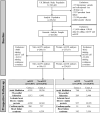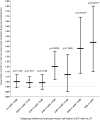Associations Between Mosaic Loss of Sex Chromosomes and Incident Hospitalization for Atrial Fibrillation in the United Kingdom
- PMID: 39508149
- PMCID: PMC11681411
- DOI: 10.1161/JAHA.124.036984
Associations Between Mosaic Loss of Sex Chromosomes and Incident Hospitalization for Atrial Fibrillation in the United Kingdom
Abstract
Background: Mosaic loss of chromosome Y (mLOY) in leukocytes of men reflects genomic instability from aging, smoking, and environmental exposures. A similar mosaic loss of chromosome X (mLOX) occurs among women. However, the associations between mLOY, mLOX, and risk of incident heart diseases are unclear.
Methods and results: We estimated associations between mLOY, mLOX, and risk of incident heart diseases requiring hospitalization, including atrial fibrillation, myocardial infarction, ischemic heart disease, cardiomyopathy, and heart failure. We analyzed 190 613 men and 224 853 women with genotyping data from the UK Biobank. Among these participants, there were 37 037 men with mLOY and 13 978 women with mLOX detected using the Mosaic Chromosomal Alterations caller. Multivariable Cox regression was used to estimate hazard ratios (HRs) and 95% CIs of each incident heart disease in relation to mLOY in men and mLOX in women. Additionally, Mendelian randomization was conducted to estimate causal associations. Among men, detectable mLOY was associated with elevated risk of atrial fibrillation (HR, 1.06 [95% CI, 1.03-1.11]). The associations were apparent in both never smokers (HR, 1.07 [95% CI, 1.01-1.14]) and ever smokers (HR, 1.05 [95% CI, 1.01-1.11]) as well as men aged >60 and ≤60 years. Mendelian randomization analyses supported causal associations between mLOY and atrial fibrillation (HRMR-PRESSO, 1.15 [95% CI, 1.13-1.18]). Among postmenopausal women, we found a suggestive inverse association between detectable mLOX and atrial fibrillation risk (HR, 0.90 [95% CI, 0.83-0.98]). However, associations with mLOY and mLOX were not found for other heart diseases.
Conclusions: Our findings suggest that mLOY and mLOX reflect sex-specific biological processes or exposure profiles related to incident atrial fibrillation requiring hospitalization.
Keywords: atrial fibrillation; heart disease; incident relative risk; mosaic loss of sex chromosomes; prospective cohort study.
Figures



Update of
-
Associations between mosaic loss of sex chromosomes and incident hospitalization for atrial fibrillation in the United Kingdom.medRxiv [Preprint]. 2024 May 31:2024.05.29.24308171. doi: 10.1101/2024.05.29.24308171. medRxiv. 2024. Update in: J Am Heart Assoc. 2024 Nov 19;13(22):e036984. doi: 10.1161/JAHA.124.036984. PMID: 38903105 Free PMC article. Updated. Preprint.
References
-
- Garcia‐Gonzalez P, de Rojas I, Moreno‐Grau S, Montrreal L, Puerta R, Alarcon‐Martin E, Quintela I, Orellana A, Andrade V, Adami PVM, et al. Mendelian randomisation confirms the role of Y‐chromosome loss in Alzheimer's disease aetiopathogenesis in men. Int J Mol Sci. 2023;24:24. doi: 10.3390/ijms24020898 - DOI - PMC - PubMed
-
- Forsberg LA, Rasi C, Malmqvist N, Davies H, Pasupulati S, Pakalapati G, Sandgren J, Diaz de Stahl T, Zaghlool A, Giedraitis V, et al. Mosaic loss of chromosome Y in peripheral blood is associated with shorter survival and higher risk of cancer. Nat Genet. 2014;46:624–628. doi: 10.1038/ng.2966 - DOI - PMC - PubMed
-
- Wong JYY, Margolis HG, Machiela M, Zhou W, Odden MC, Psaty BM, Robbins J, Jones RR, Rotter JI, Chanock SJ, et al. Outdoor air pollution and mosaic loss of chromosome Y in older men from the cardiovascular health study. Environ Int. 2018;116:239–247. doi: 10.1016/j.envint.2018.04.030 - DOI - PMC - PubMed
MeSH terms
LinkOut - more resources
Full Text Sources
Medical

